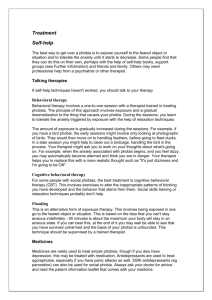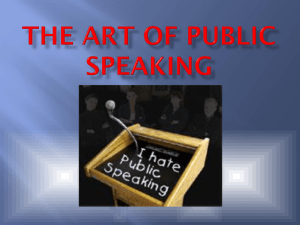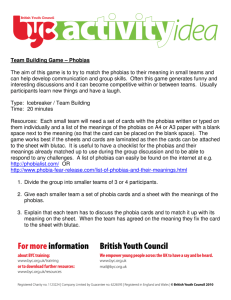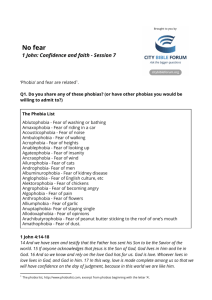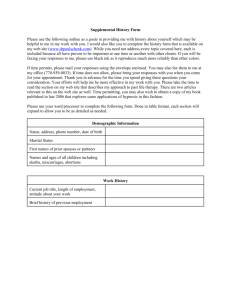Therapy Process - Academy of Applied Hypnosis
advertisement
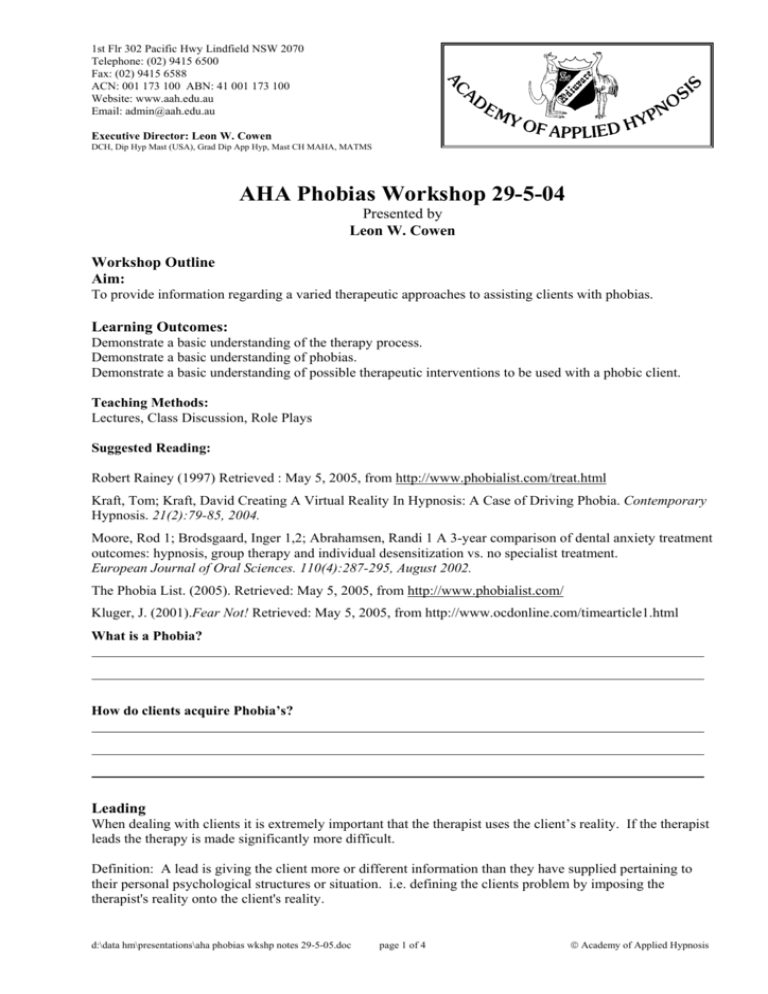
1st Flr 302 Pacific Hwy Lindfield NSW 2070 Telephone: (02) 9415 6500 Fax: (02) 9415 6588 ACN: 001 173 100 ABN: 41 001 173 100 Website: www.aah.edu.au Email: admin@aah.edu.au Executive Director: Leon W. Cowen DCH, Dip Hyp Mast (USA), Grad Dip App Hyp, Mast CH MAHA, MATMS AHA Phobias Workshop 29-5-04 Presented by Leon W. Cowen Workshop Outline Aim: To provide information regarding a varied therapeutic approaches to assisting clients with phobias. Learning Outcomes: Demonstrate a basic understanding of the therapy process. Demonstrate a basic understanding of phobias. Demonstrate a basic understanding of possible therapeutic interventions to be used with a phobic client. Teaching Methods: Lectures, Class Discussion, Role Plays Suggested Reading: Robert Rainey (1997) Retrieved : May 5, 2005, from http://www.phobialist.com/treat.html Kraft, Tom; Kraft, David Creating A Virtual Reality In Hypnosis: A Case of Driving Phobia. Contemporary Hypnosis. 21(2):79-85, 2004. Moore, Rod 1; Brodsgaard, Inger 1,2; Abrahamsen, Randi 1 A 3-year comparison of dental anxiety treatment outcomes: hypnosis, group therapy and individual desensitization vs. no specialist treatment. European Journal of Oral Sciences. 110(4):287-295, August 2002. The Phobia List. (2005). Retrieved: May 5, 2005, from http://www.phobialist.com/ Kluger, J. (2001).Fear Not! Retrieved: May 5, 2005, from http://www.ocdonline.com/timearticle1.html What is a Phobia? How do clients acquire Phobia’s? Leading When dealing with clients it is extremely important that the therapist uses the client’s reality. If the therapist leads the therapy is made significantly more difficult. Definition: A lead is giving the client more or different information than they have supplied pertaining to their personal psychological structures or situation. i.e. defining the clients problem by imposing the therapist's reality onto the client's reality. d:\data hm\presentations\aha phobias wkshp notes 29-5-05.doc page 1 of 4 Academy of Applied Hypnosis Types of Leads Client says: ‘ I'm confused, my wife says she loves me but I just don't know any more.’ Obvious Not Obvious If you're confused she might be as well? Does don't know any more mean you Heard the client don't want to stay in the relationship? It's hard to know what to do? Not heard the Client How long have you been married? A false memory can also be implanted when a therapist tries to change a previous event. Even if the client makes a statement ‘ I wish it didn't happen that way’ or ‘I wish I could change that’ realise that you cannot change the event. The only thing that can change is the attitude of the client to the event and only if the client wishes to do so. Leading is how false memories are implanted. Be very careful Therapy Process This model represents the potential treatment pathways when treating a client. The demonstrates 3 possible approaches (although more do exist) for the Clinical Hypnotherapist. Client Presents with Symptoms – Feelings / Logic Counselling Identify symptoms Identify the issue Explore the feelings & emotions What do they want to do How will we know when we have achieved our outcome Any Paradoxes Feelings / Logic Analytical Feelings / Logic Awareness What do these techniques do? What do these techniques do? What techniques can be used? Progression, Regression Automatic Writing,Ideomotor Quest, Dream Therapy What techniques can be used? Hyp Empty Chair, Empty Chr, Counselling, Mini Script Life Script Why choose this alternative? Why choose this alternative? Feelings / Logic Behaviour Modification What do these techniques do? What techniques can be used? Cognitive Behavioural Therapy Cognitive Thpy, Behaviour Thpy Rational Emotive Therapy, Anchoring and Collapsing Anchors Why choose this alternative? Resolution of Issue Notes: d:\data hm\presentations\aha phobias wkshp notes 29-5-05.doc page 2 of 4 Academy of Applied Hypnosis Therapeutic Approaches Depends on the client’s requirements. 1 Hypnoanalysis: If the client wants to find the cause hypnoanalytical techniques are best. These techniques (commonly referred to as PRAID) are: Progression. Regression (not age regression. Age regression is one form of regression.) Automatic (Autonomic) Writing Ideomotor Questioning Dream Therapy The aim of the Hypnoanalytical Techniques is to find the cause. E.g. Regression to the first time the client experienced this specific fear. Be very careful, if your regression places the client back in the traumatic situation you could re-traumatise the client. 2 Awareness: If the client wants to understand the phobia then humanistic / existential techniques are best. E.g. Hypnotic Empty Chair – where the figure (the client’s main focus) is placed on the imaginary chair and the client discusses their phobia 3 Behaviour Modification: If the client just wants to change their behaviour. E.g. no fear when they are confronted with the stimulus. Techniques could be Systematic Desensitisation or Anchoring and Collapsing Anchors. Anchoring and Collapsing Anchors can look like magic when done correctly. Systematic Desensitisation is the practical therapeutic application of classical conditioning. Systematic Desensitisation is where a hierarchy of fear responses is established. E.g. a list is established from the stimulus which elicits the least amount of fear to the stimulus which elicits the greatest amount of fear. The list may have 100 components. Each step in the list is then paired with the relaxation response. This means the client learns to relax and in the safety of the therapy room the therapist helps them achieve the lowest level of phobic fear and then links it to relaxation. In this way the fear disappears and is replaced with the relaxation. This process is continues until all steps in the list have been nullified by linking the fear to the relaxation. Notes: d:\data hm\presentations\aha phobias wkshp notes 29-5-05.doc page 3 of 4 Academy of Applied Hypnosis Anchoring and Collapsing Anchors is an NLP technique. This technique is extremely beneficial for clients who have a concept that there are alternatives to their current behaviour. Although not essential opposing, awareness's of the same incident are often the best as it is easier to show the distinction between the awareness's. e.g. Phobia: Awareness 1 (unwanted behaviour) Fear, heat, nausea Awareness 2 (wanted behaviour) Illogical to be scared What you are doing is giving the client a choice of a new response from the unwanted stimulus. You will often find you are blending feelings and logic (possibly ‘Reparenting). This outline is a Kinaesthetic Anchor and Blend. The ‘Swish’ technique is a visual method of Anchoring and Blending. Because this technique can involve touching the client you must get permission prior to using the technique. Only touch in safe places e.g. hands or feet. 1 Warm up ‘Awareness 1’ then give suggestions that when I touch this finger (select a finger) you will experience the fear, heat, nausea. Always institute the anchor as the feelings are rising and just before they reach their apex. 2 Check that the ‘anchor’ (post hypnotic trigger) is effective by touching the trigger and observing the conditioned response. The response needs to be strong which can be distressing for some clients so take care. If it is not strong enough then repeat Step 1 3 Repeat steps 1 and 2 for awareness 2 till both anchors are very strong. 4 ‘Blend or Collapse’ the anchors by triggering the responses simultaneously. It may be necessary to remove the stimulation from one trigger to allow the desired behaviours to increase in their potency thereby giving more equal stimulation. 5 Once the reactions have ceased return the anchors to normal. Give the appropriate positive suggestions and check if the warming up of ‘Awareness 1’ has the original effects. It would be expected that the client would have a different awareness and behaviour than they did initially. Applying the Technique 1 Warm up awareness 1. 2 Anchor it to the selected location 3 Check the anchor for awareness 1 is responsive 4 Release the anchor for awareness 1 5 Warm up awareness 2. 6 Anchor it to the selected location 7 Check the anchor is responsive for awareness 2 is responsive 8 Trigger both anchors individually to ensure the required responsiveness is present. 9 Trigger both anchors simultaneously (Collapsing) until the response subsides 10 Return the trigger points to normal and check the response to the technique. Notes: d:\data hm\presentations\aha phobias wkshp notes 29-5-05.doc page 4 of 4 Academy of Applied Hypnosis

